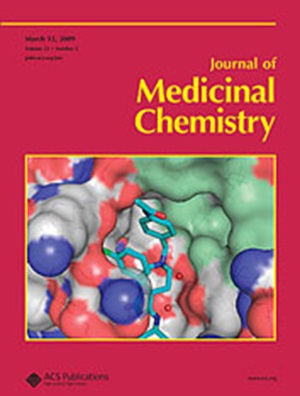结构-活性关系引导的支架跳跃导致GLPG4970的鉴定,这是一种高效的SIK2/SIK3双抑制剂。
IF 6.8
1区 医学
Q1 CHEMISTRY, MEDICINAL
引用次数: 0
摘要
抑制盐诱导激酶(SIKs) SIK1、SIK2和SIK3通过调节促炎和免疫调节途径,特别是抑制SIK2和SIK3,代表了一种新的潜在的治疗自身免疫性和炎症性疾病的方法。在发现了抑制SIK的新化学型后,进一步优化了效价、选择性、ADMET和PK性质,得到了含有1,6-萘嘧啶的分子GLPG4876(7)。然而,在大鼠体内微核实验中,7是致裂性的,阻止了进一步的发展。7与GLPG3970(6)叠加在SIK3蛋白结构内,启发了吡啶衍生物的设计,最终鉴定出GLPG4970(8)。化合物8在遗传毒性筛选试验中呈阴性,并表现出有效的SIK2/SIK3抑制作用,在细胞环境中确定了同种异构体的选择性。与先前报道的SIK抑制剂相比,化合物8在生化和表型细胞分析中显示出更高的效力,并且在疾病相关小鼠结肠炎药理学模型中显示出剂量依赖性活性。本文章由计算机程序翻译,如有差异,请以英文原文为准。
Structure-Activity Relationship Guided Scaffold Hopping Resulted in the Identification of GLPG4970, a Highly Potent Dual SIK2/SIK3 Inhibitor.
Inhibition of salt-inducible kinases (SIKs) SIK1, SIK2, and SIK3 represents a new potential therapeutic approach for autoimmune and inflammatory disease treatment via modulation of pro-inflammatory and immunoregulatory pathways, particularly inhibition of SIK2 and SIK3. After discovering a new chemotype for SIK inhibition, further optimization of potency, selectivity, ADMET and PK properties resulted in a 1,6-naphtyridine containing molecule GLPG4876 (7). However, 7 was clastogenic when examined in vivo in rat micronucleus assays, preventing further development. Overlay of 7 with GLPG3970 (6) within the SIK3 protein structure inspired the design of pyridine derivatives, leading to the identification of GLPG4970 (8). Compound 8 was negative in genotoxicity screening assays and demonstrated potent SIK2/SIK3 inhibition, for which isoform selectivity was determined in a cellular context. Compound 8 displayed improved potency compared with previously reported SIK inhibitors in biochemical and phenotypic cellular assays, and showed dose-dependent activity in disease relevant mouse pharmacological models of colitis.
求助全文
通过发布文献求助,成功后即可免费获取论文全文。
去求助
来源期刊

Journal of Medicinal Chemistry
医学-医药化学
CiteScore
4.00
自引率
11.00%
发文量
804
审稿时长
1.9 months
期刊介绍:
The Journal of Medicinal Chemistry is a prestigious biweekly peer-reviewed publication that focuses on the multifaceted field of medicinal chemistry. Since its inception in 1959 as the Journal of Medicinal and Pharmaceutical Chemistry, it has evolved to become a cornerstone in the dissemination of research findings related to the design, synthesis, and development of therapeutic agents.
The Journal of Medicinal Chemistry is recognized for its significant impact in the scientific community, as evidenced by its 2022 impact factor of 7.3. This metric reflects the journal's influence and the importance of its content in shaping the future of drug discovery and development. The journal serves as a vital resource for chemists, pharmacologists, and other researchers interested in the molecular mechanisms of drug action and the optimization of therapeutic compounds.
 求助内容:
求助内容: 应助结果提醒方式:
应助结果提醒方式:


